Copyright© 2004 South-Western 1414 Firms in Competitive Markets

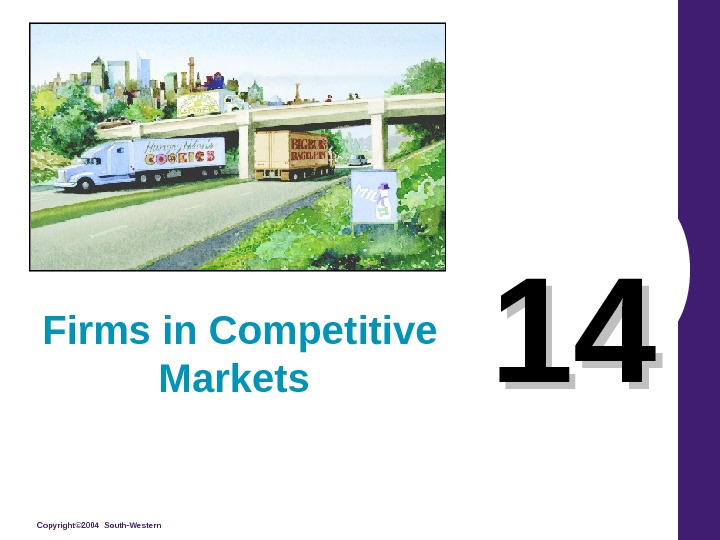
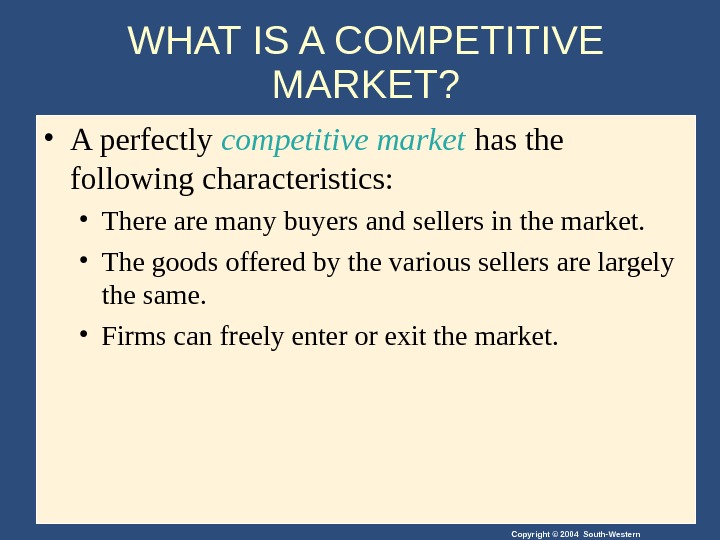
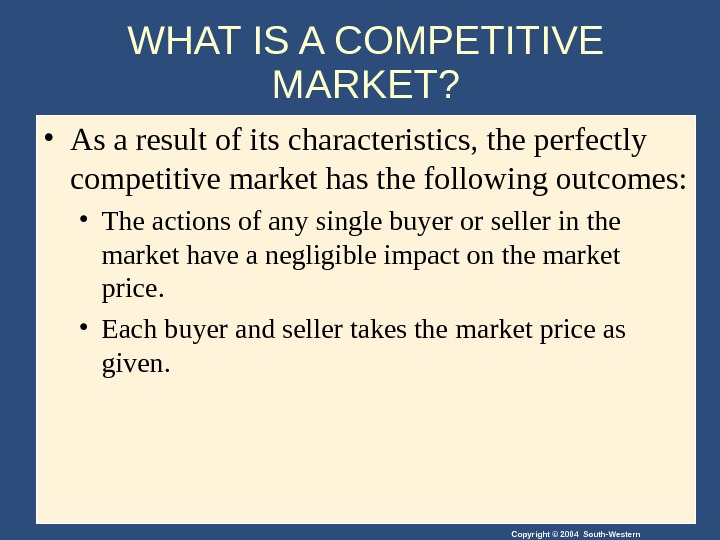
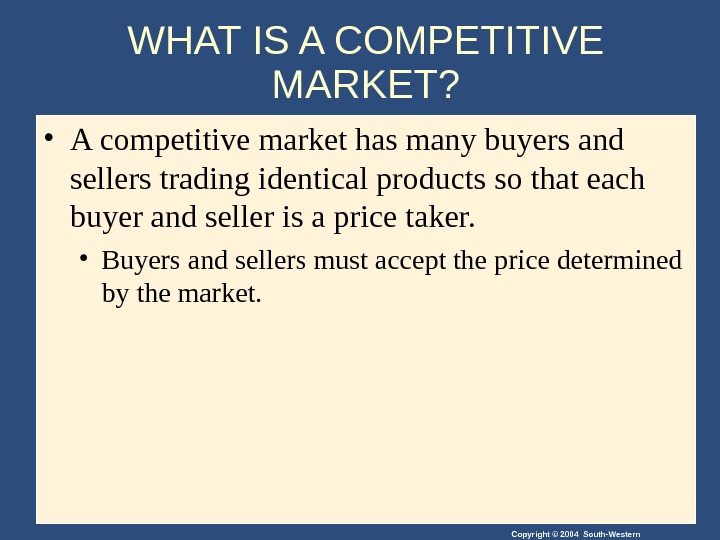
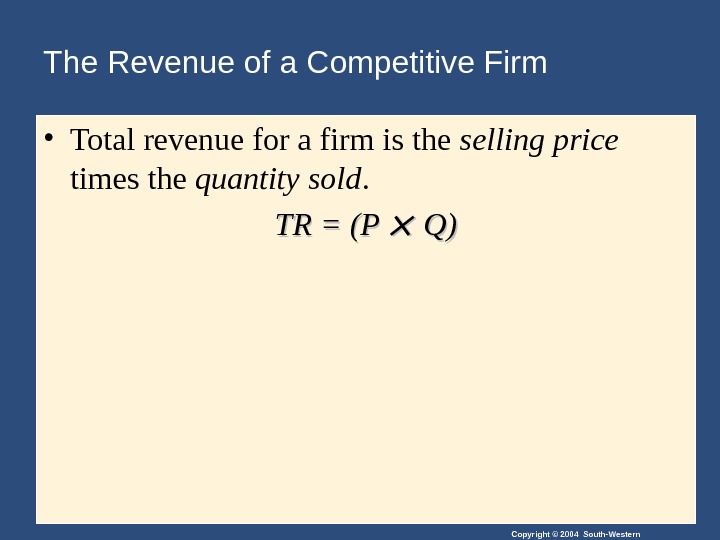
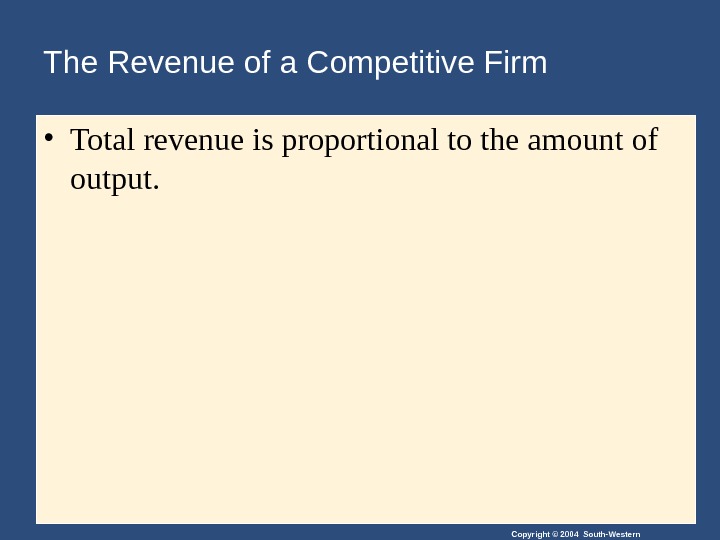
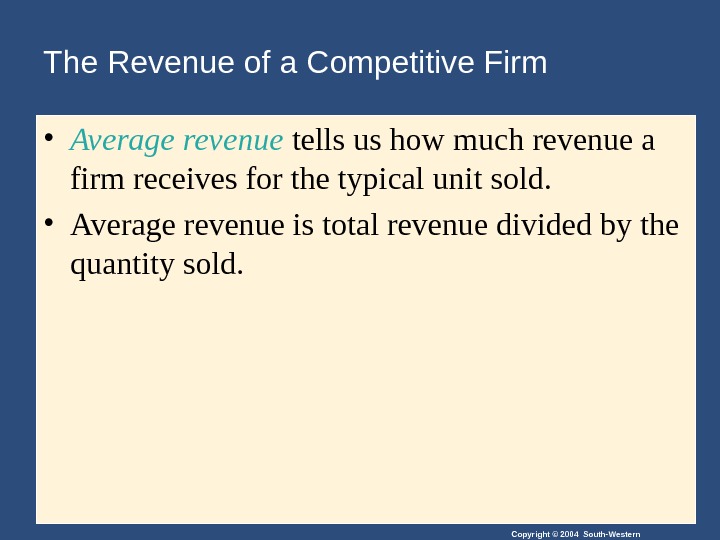
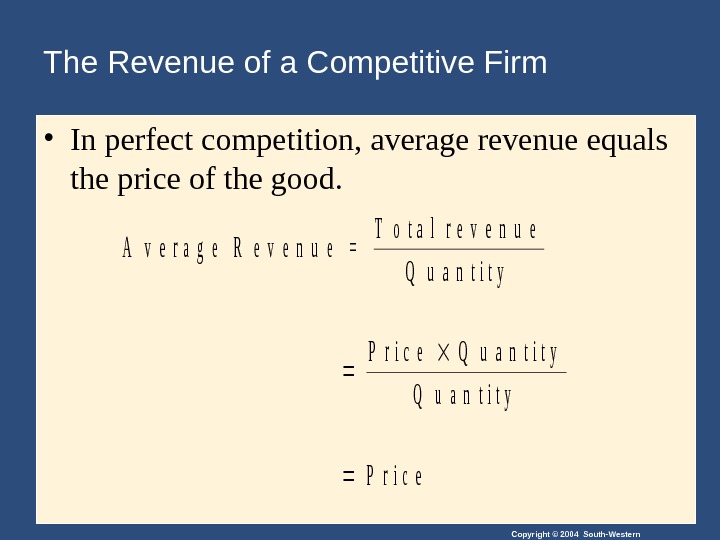
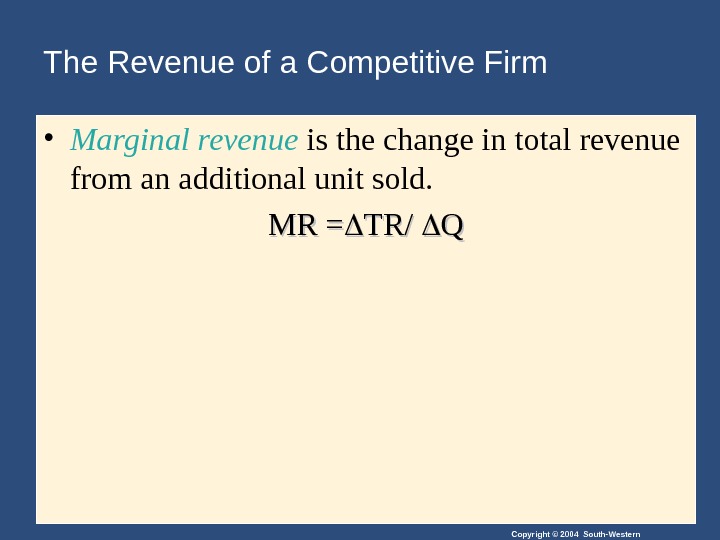

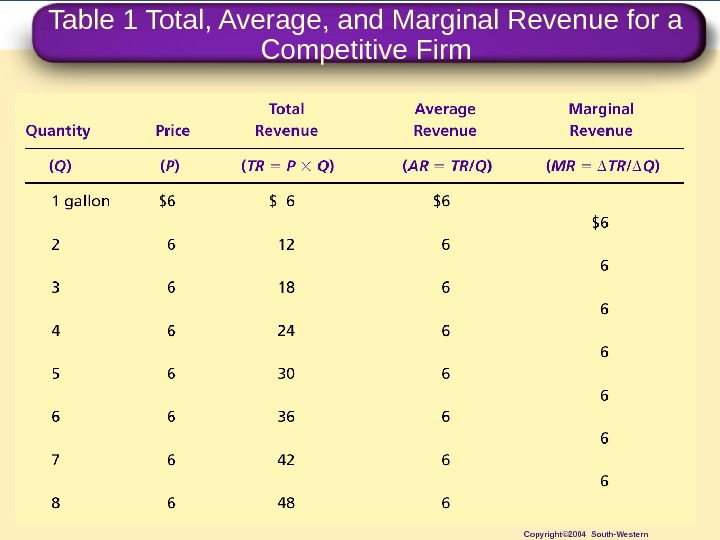
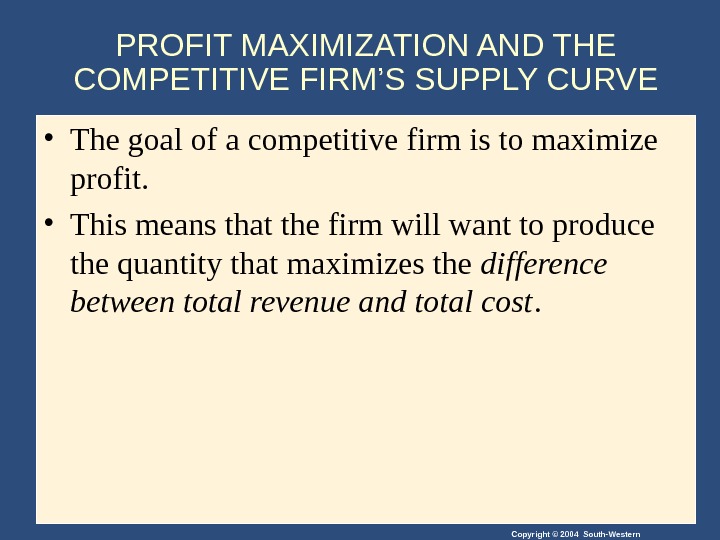

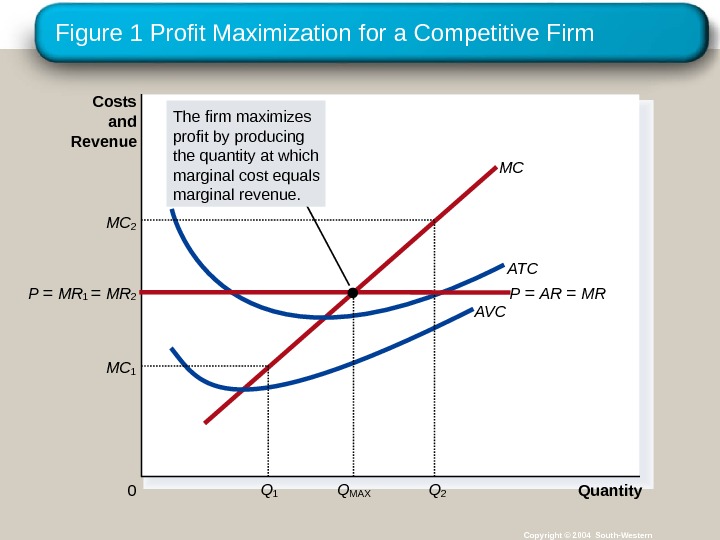
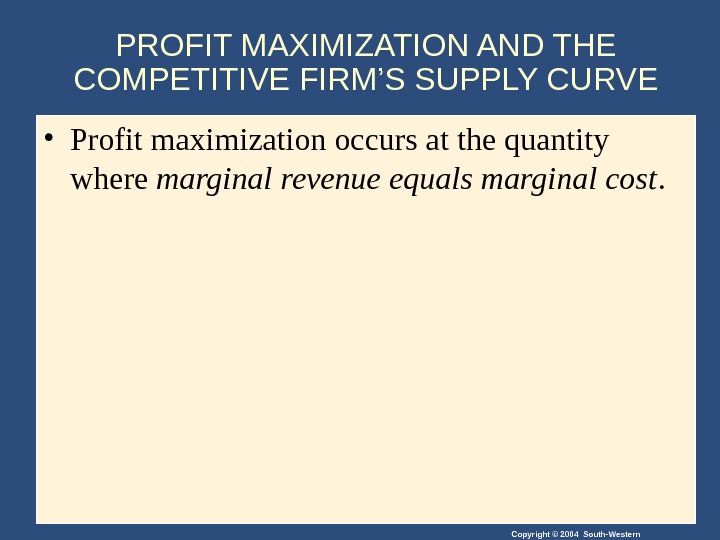
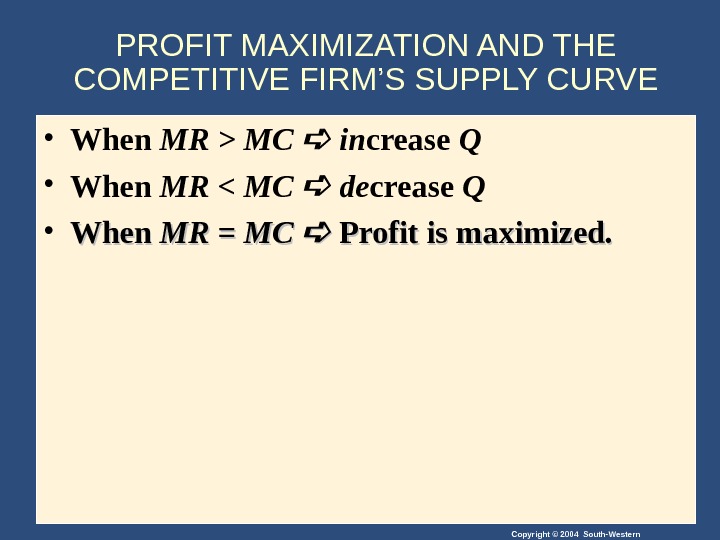


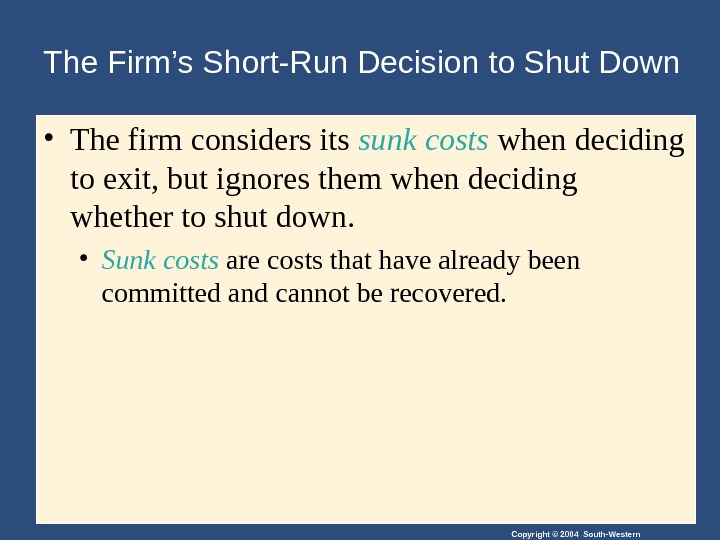
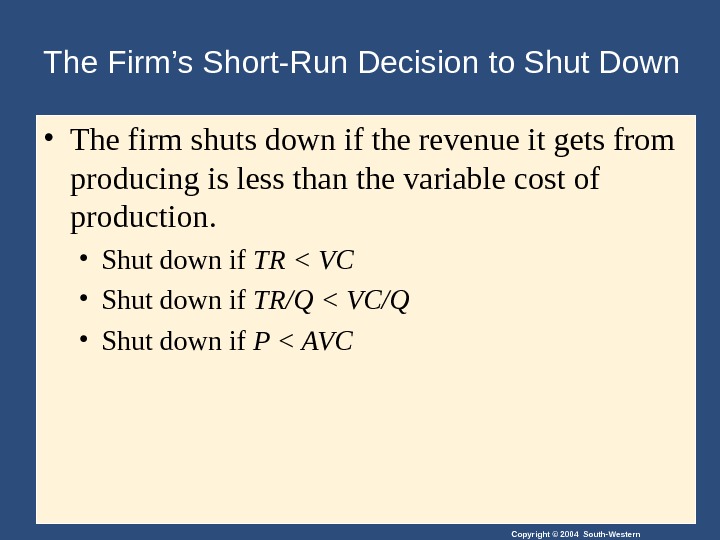
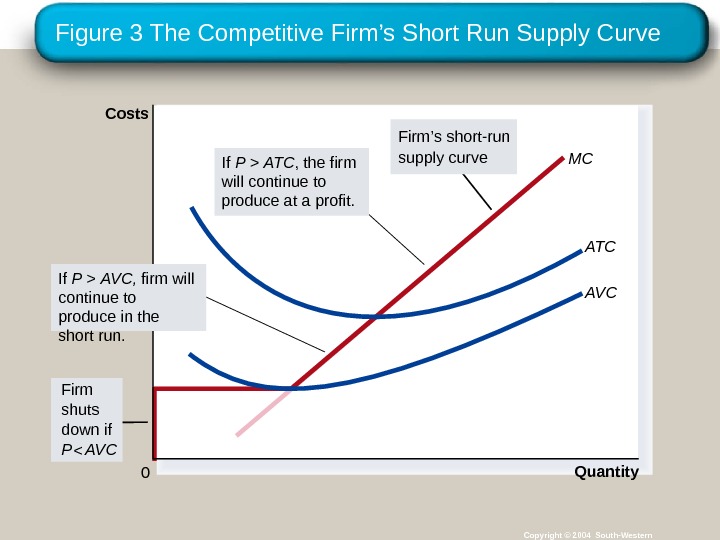
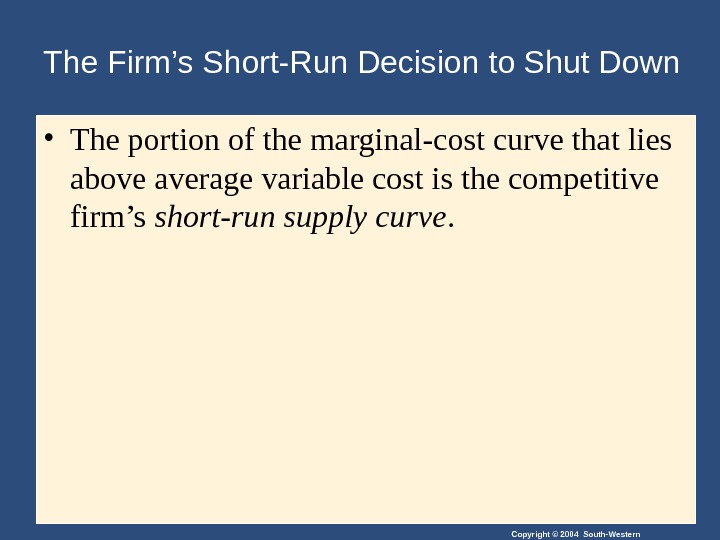
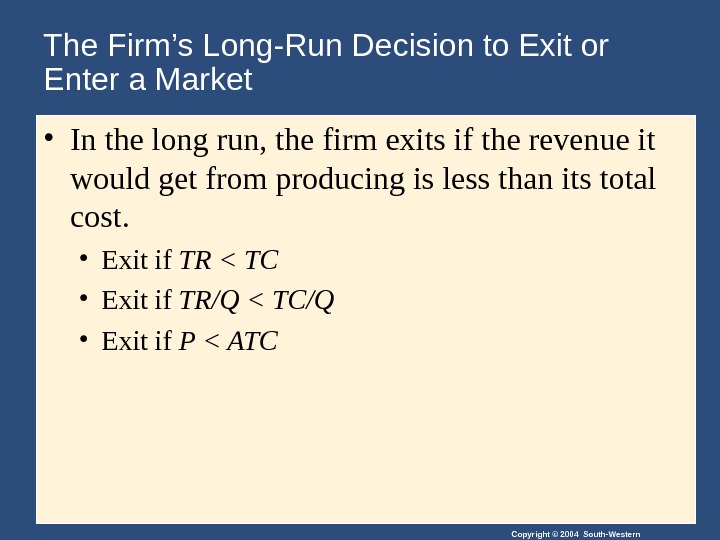
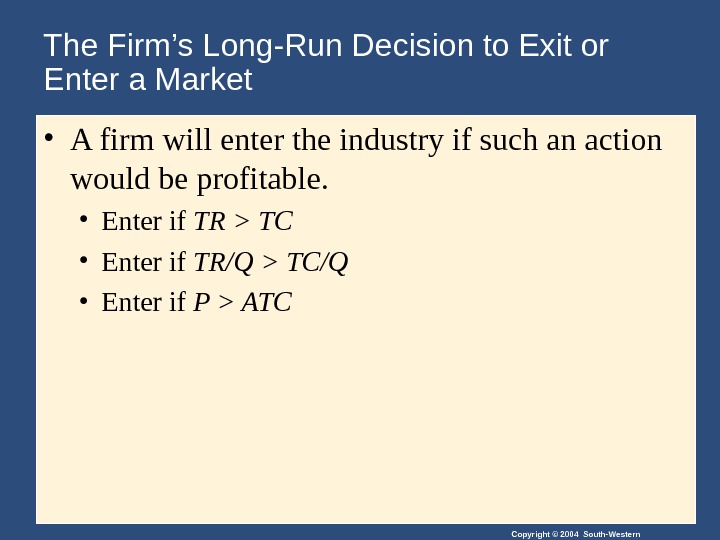

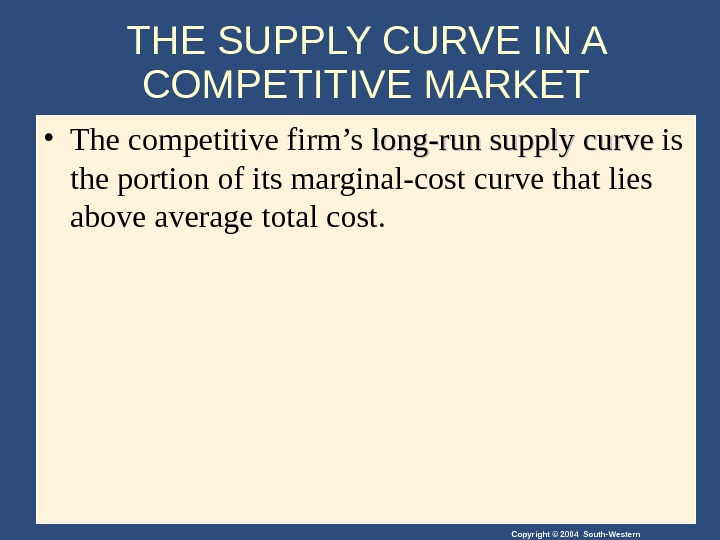
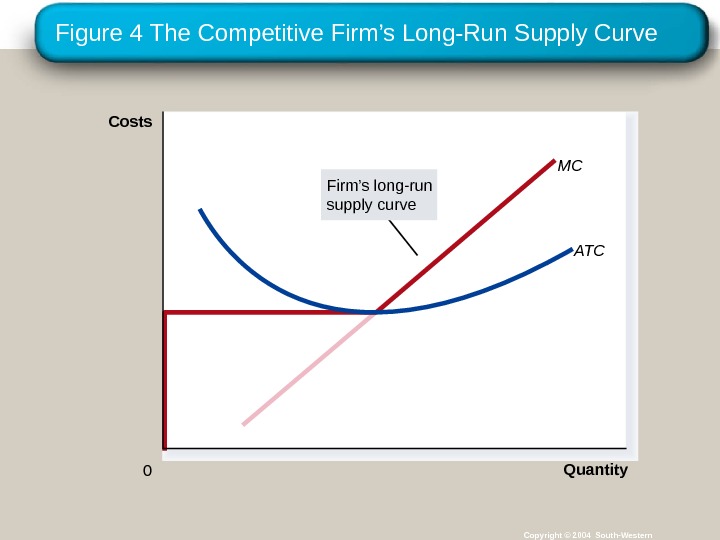
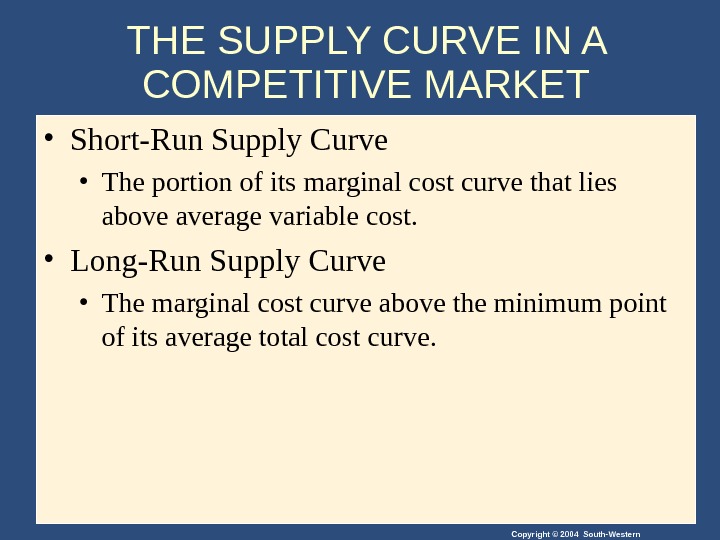

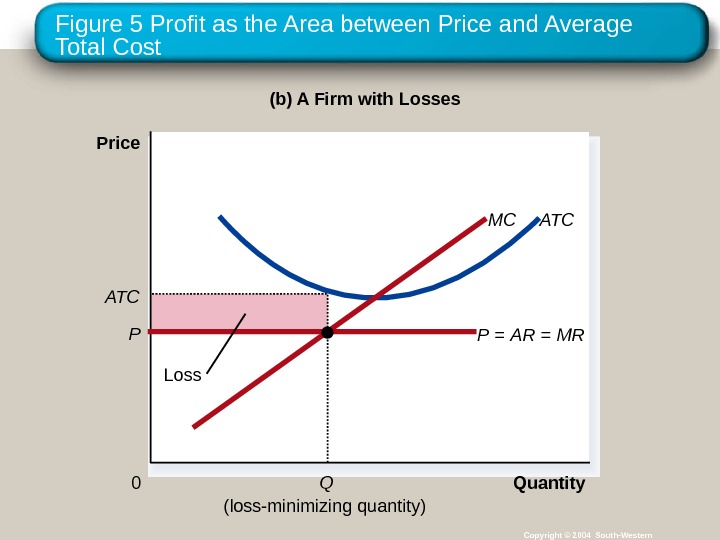
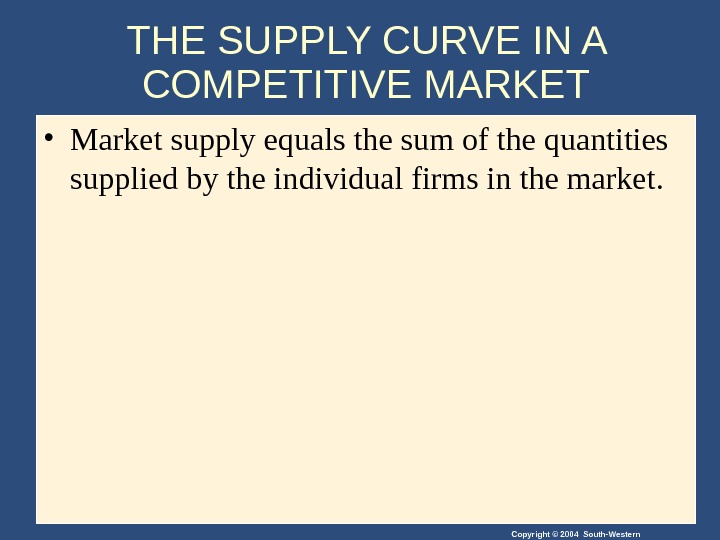
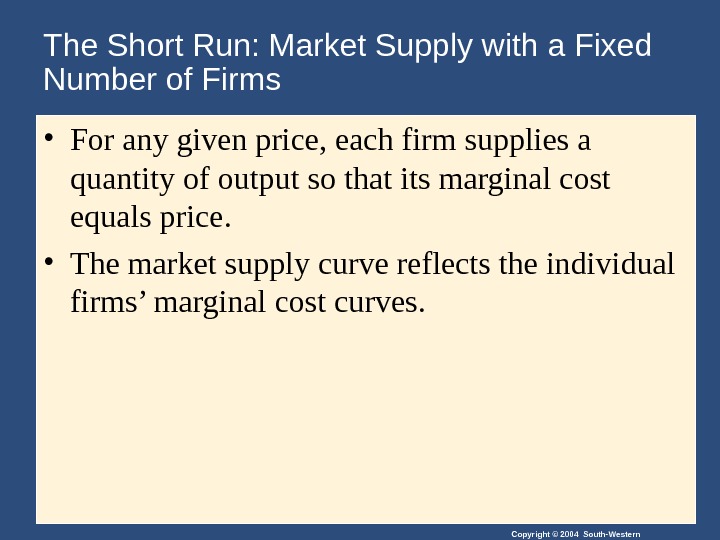
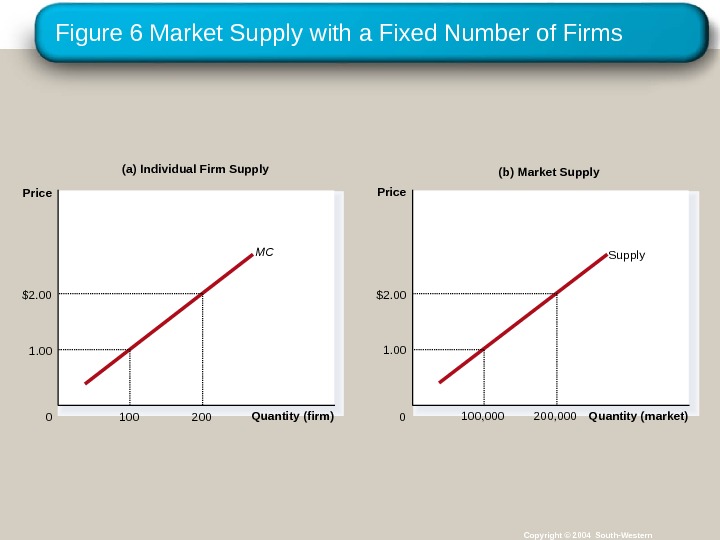
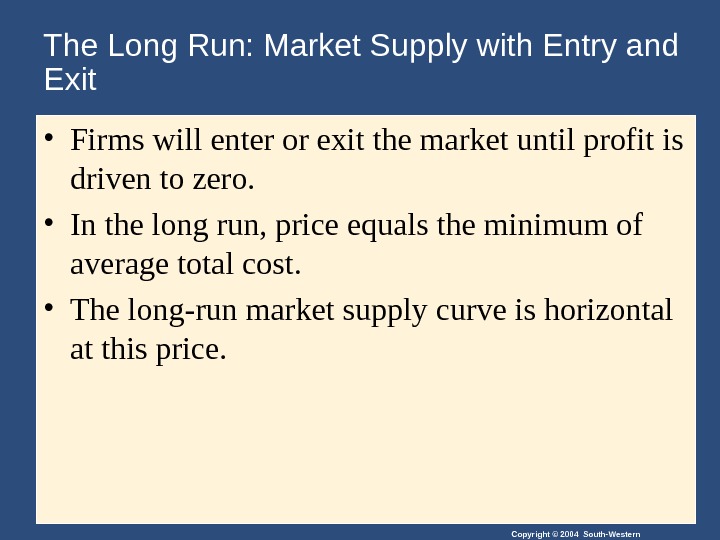


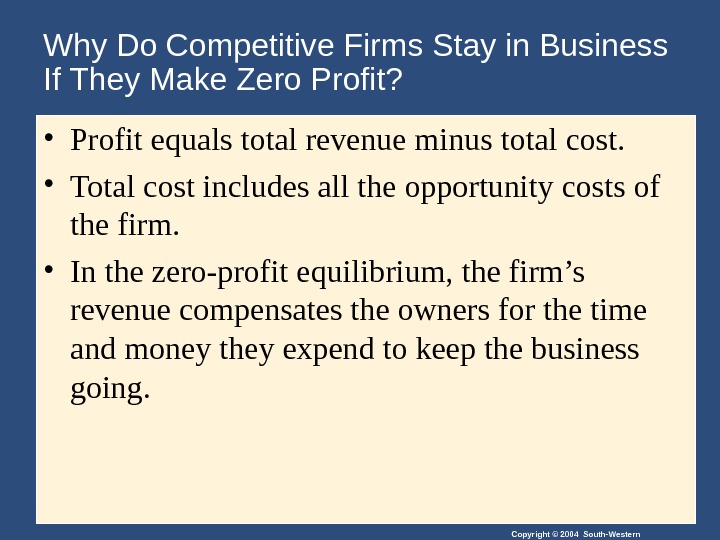
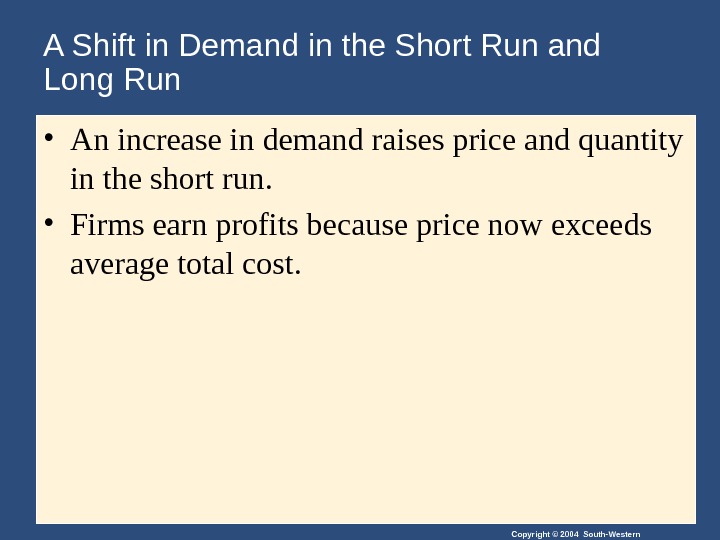
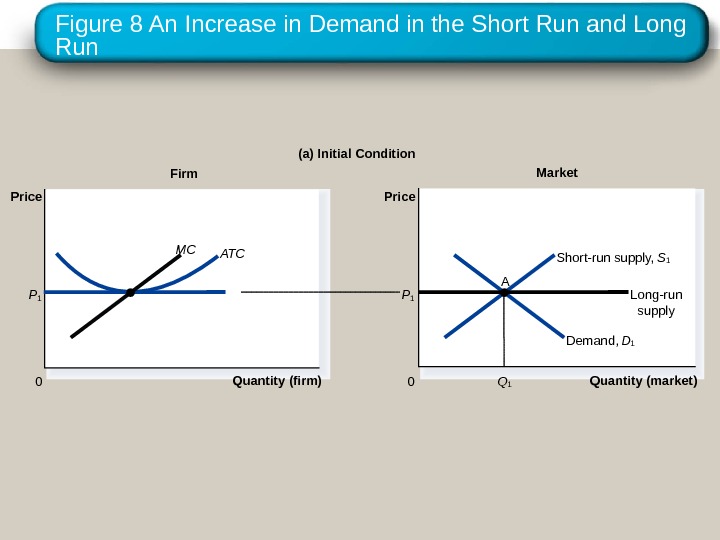
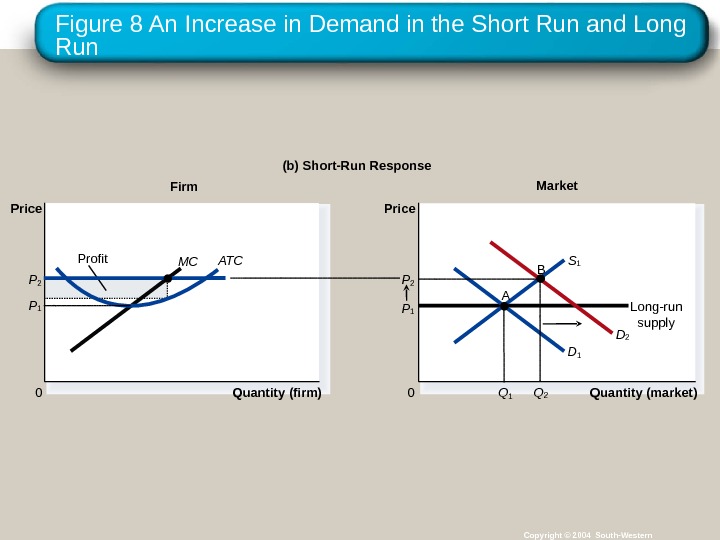


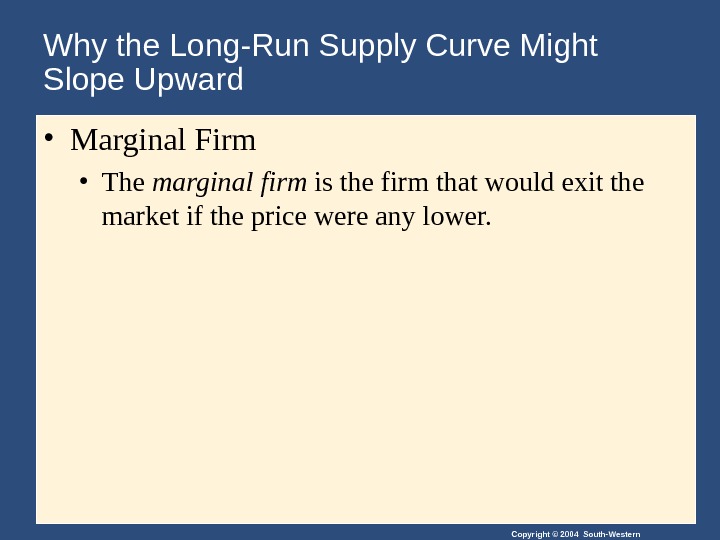
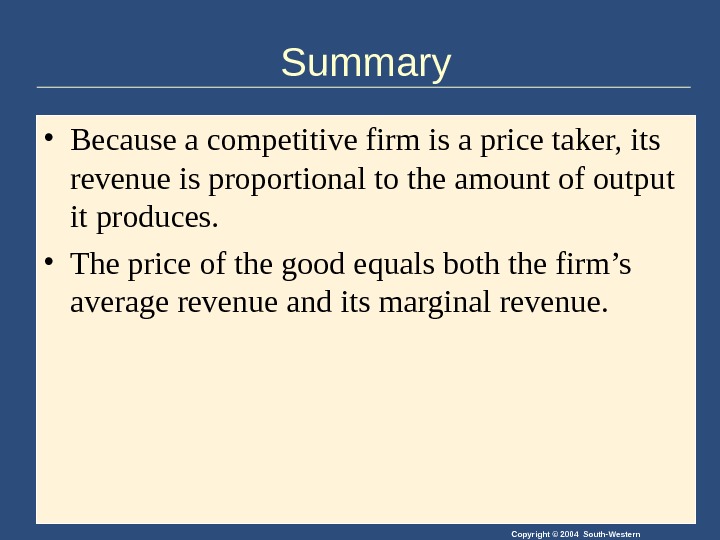
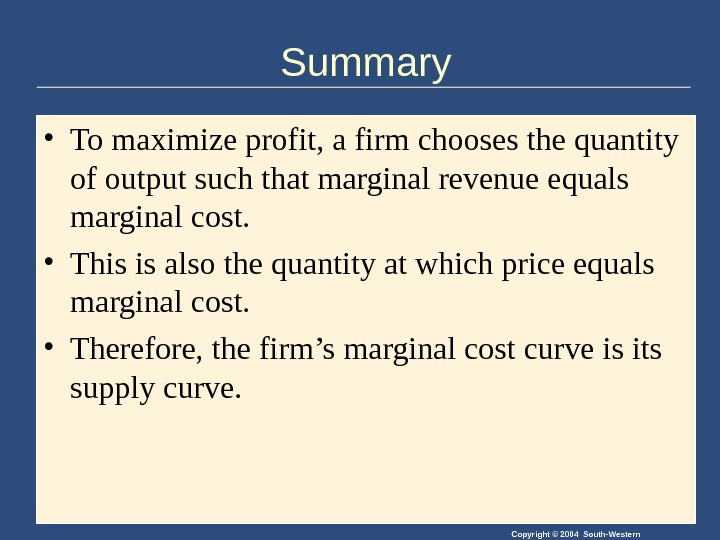
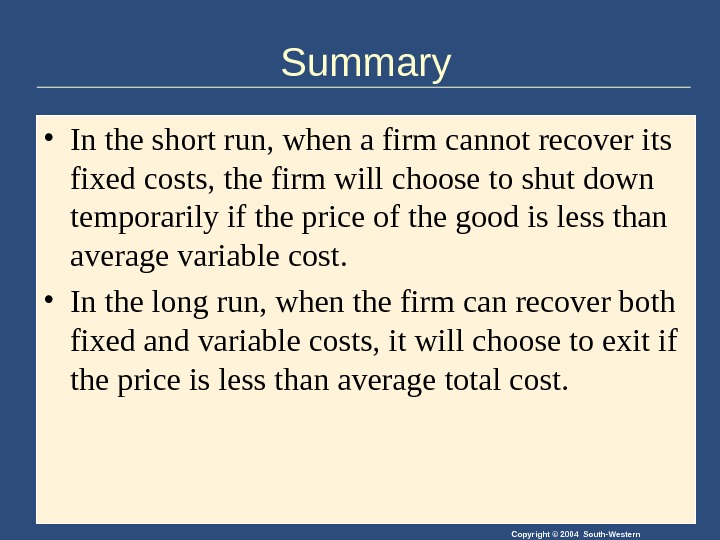
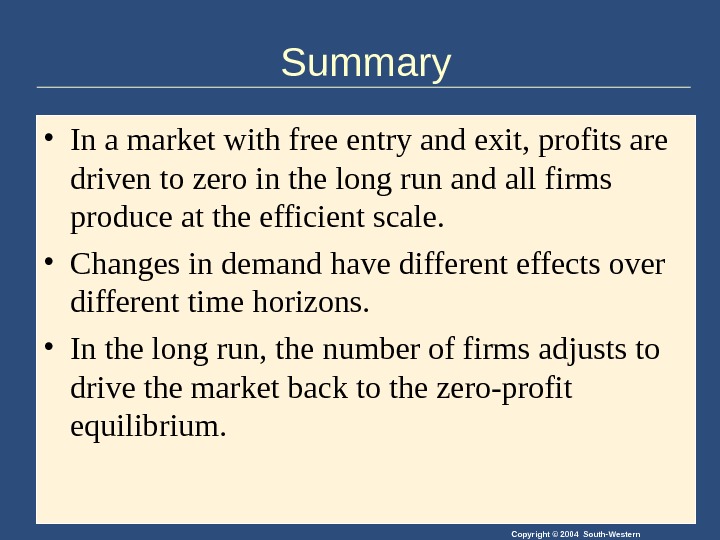
session6_firms_in_competitive_markets.ppt
- Размер: 1.4 Mегабайта
- Количество слайдов: 47
Описание презентации Copyright© 2004 South-Western 1414 Firms in Competitive Markets по слайдам
 Copyright© 2004 South-Western 1414 Firms in Competitive Markets
Copyright© 2004 South-Western 1414 Firms in Competitive Markets
 Copyright © 2004 South-Western. WHAT IS A COMPETITIVE MARKET? • A perfectly competitive market has the following characteristics: • There are many buyers and sellers in the market. • The goods offered by the various sellers are largely the same. • Firms can freely enter or exit the market.
Copyright © 2004 South-Western. WHAT IS A COMPETITIVE MARKET? • A perfectly competitive market has the following characteristics: • There are many buyers and sellers in the market. • The goods offered by the various sellers are largely the same. • Firms can freely enter or exit the market.
 Copyright © 2004 South-Western. WHAT IS A COMPETITIVE MARKET? • As a result of its characteristics, the perfectly competitive market has the following outcomes: • The actions of any single buyer or seller in the market have a negligible impact on the market price. • Each buyer and seller takes the market price as given.
Copyright © 2004 South-Western. WHAT IS A COMPETITIVE MARKET? • As a result of its characteristics, the perfectly competitive market has the following outcomes: • The actions of any single buyer or seller in the market have a negligible impact on the market price. • Each buyer and seller takes the market price as given.
 Copyright © 2004 South-Western. WHAT IS A COMPETITIVE MARKET? • A competitive market has many buyers and sellers trading identical products so that each buyer and seller is a price taker. • Buyers and sellers must accept the price determined by the market.
Copyright © 2004 South-Western. WHAT IS A COMPETITIVE MARKET? • A competitive market has many buyers and sellers trading identical products so that each buyer and seller is a price taker. • Buyers and sellers must accept the price determined by the market.
 Copyright © 2004 South-Western. The Revenue of a Competitive Firm • Total revenue for a firm is the selling price times the quantity sold. TR = (P Q) Q)
Copyright © 2004 South-Western. The Revenue of a Competitive Firm • Total revenue for a firm is the selling price times the quantity sold. TR = (P Q) Q)
 Copyright © 2004 South-Western. The Revenue of a Competitive Firm • Total revenue is proportional to the amount of output.
Copyright © 2004 South-Western. The Revenue of a Competitive Firm • Total revenue is proportional to the amount of output.
 Copyright © 2004 South-Western. The Revenue of a Competitive Firm • Average revenue tells us how much revenue a firm receives for the typical unit sold. • Average revenue is total revenue divided by the quantity sold.
Copyright © 2004 South-Western. The Revenue of a Competitive Firm • Average revenue tells us how much revenue a firm receives for the typical unit sold. • Average revenue is total revenue divided by the quantity sold.
 Copyright © 2004 South-Western. The Revenue of a Competitive Firm • In perfect competition, average revenue equals the price of the good. A v e r a g e R ev e n u e= T o t a l r e v en u e Q u a n t i t y P r i c e
Copyright © 2004 South-Western. The Revenue of a Competitive Firm • In perfect competition, average revenue equals the price of the good. A v e r a g e R ev e n u e= T o t a l r e v en u e Q u a n t i t y P r i c e
 Copyright © 2004 South-Western. The Revenue of a Competitive Firm • Marginal revenue is the change in total revenue from an additional unit sold. MR = TR/ QQ
Copyright © 2004 South-Western. The Revenue of a Competitive Firm • Marginal revenue is the change in total revenue from an additional unit sold. MR = TR/ QQ
 Copyright © 2004 South-Western. The Revenue of a Competitive Firm • For competitive firms, marginal revenue equals the price of the good.
Copyright © 2004 South-Western. The Revenue of a Competitive Firm • For competitive firms, marginal revenue equals the price of the good.
 Table 1 Total, Average, and Marginal Revenue for a Competitive Firm Copyright© 2004 South-Western
Table 1 Total, Average, and Marginal Revenue for a Competitive Firm Copyright© 2004 South-Western
 Copyright © 2004 South-Western. PROFIT MAXIMIZATION AND THE COMPETITIVE FIRM’S SUPPLY CURVE • The goal of a competitive firm is to maximize profit. • This means that the firm will want to produce the quantity that maximizes the difference between total revenue and total cost.
Copyright © 2004 South-Western. PROFIT MAXIMIZATION AND THE COMPETITIVE FIRM’S SUPPLY CURVE • The goal of a competitive firm is to maximize profit. • This means that the firm will want to produce the quantity that maximizes the difference between total revenue and total cost.
 Table 2 Profit Maximization: A Numerical Example Copyright© 2004 South-Western
Table 2 Profit Maximization: A Numerical Example Copyright© 2004 South-Western
 Figure 1 Profit Maximization for a Competitive Firm Copyright © 2004 South-Western Quantity 0 Costs and Revenue MC ATC AVC MC 1 Q 1 MC 2 Q 2 The firm maximizes profit by producing the quantity at which marginal cost equals marginal revenue. Q MAX P = MR 1 = MR 2 P = AR = MR
Figure 1 Profit Maximization for a Competitive Firm Copyright © 2004 South-Western Quantity 0 Costs and Revenue MC ATC AVC MC 1 Q 1 MC 2 Q 2 The firm maximizes profit by producing the quantity at which marginal cost equals marginal revenue. Q MAX P = MR 1 = MR 2 P = AR = MR
 Copyright © 2004 South-Western. PROFIT MAXIMIZATION AND THE COMPETITIVE FIRM’S SUPPLY CURVE • Profit maximization occurs at the quantity where marginal revenue equals marginal cost.
Copyright © 2004 South-Western. PROFIT MAXIMIZATION AND THE COMPETITIVE FIRM’S SUPPLY CURVE • Profit maximization occurs at the quantity where marginal revenue equals marginal cost.
 Copyright © 2004 South-Western. PROFIT MAXIMIZATION AND THE COMPETITIVE FIRM’S SUPPLY CURVE • When MR > MC in crease Q • When MR < MC de crease Q • When MR = MC Profit is maximized. .
Copyright © 2004 South-Western. PROFIT MAXIMIZATION AND THE COMPETITIVE FIRM’S SUPPLY CURVE • When MR > MC in crease Q • When MR < MC de crease Q • When MR = MC Profit is maximized. .
 Figure 2 Marginal Cost as the Competitive Firm’s Supply Curve Copyright © 2004 South-Western Quantity 0 Price MC ATC AVCP 1 Q 1 P 2 Q 2 This section of the firm’s MC curve is also the firm’s supply curve.
Figure 2 Marginal Cost as the Competitive Firm’s Supply Curve Copyright © 2004 South-Western Quantity 0 Price MC ATC AVCP 1 Q 1 P 2 Q 2 This section of the firm’s MC curve is also the firm’s supply curve.
 Copyright © 2004 South-Western. The Firm’s Short-Run Decision to Shut Down • A shutdown refers to a short-run decision not to produce anything during a specific period of time because of current market conditions. • Exit refers to a long-run decision to leave the market.
Copyright © 2004 South-Western. The Firm’s Short-Run Decision to Shut Down • A shutdown refers to a short-run decision not to produce anything during a specific period of time because of current market conditions. • Exit refers to a long-run decision to leave the market.
 Copyright © 2004 South-Western. The Firm’s Short-Run Decision to Shut Down • The firm considers its sunk costs when deciding to exit, but ignores them when deciding whether to shut down. • Sunk costs are costs that have already been committed and cannot be recovered.
Copyright © 2004 South-Western. The Firm’s Short-Run Decision to Shut Down • The firm considers its sunk costs when deciding to exit, but ignores them when deciding whether to shut down. • Sunk costs are costs that have already been committed and cannot be recovered.
 Copyright © 2004 South-Western. The Firm’s Short-Run Decision to Shut Down • The firm shuts down if the revenue it gets from producing is less than the variable cost of production. • Shut down if TR < VC • Shut down if TR/Q < VC/Q • Shut down if P < AV
Copyright © 2004 South-Western. The Firm’s Short-Run Decision to Shut Down • The firm shuts down if the revenue it gets from producing is less than the variable cost of production. • Shut down if TR < VC • Shut down if TR/Q < VC/Q • Shut down if P < AV
 Figure 3 The Competitive Firm’s Short Run Supply Curve Copyright © 2004 South-Western MC Quantity ATC AVC 0 Costs Firm shuts down if P AVC, firm will continue to produce in the short run. If P > ATC , the firm will continue to produce at a profit.
Figure 3 The Competitive Firm’s Short Run Supply Curve Copyright © 2004 South-Western MC Quantity ATC AVC 0 Costs Firm shuts down if P AVC, firm will continue to produce in the short run. If P > ATC , the firm will continue to produce at a profit.
 Copyright © 2004 South-Western. The Firm’s Short-Run Decision to Shut Down • The portion of the marginal-cost curve that lies above average variable cost is the competitive firm’s short-run supply curve.
Copyright © 2004 South-Western. The Firm’s Short-Run Decision to Shut Down • The portion of the marginal-cost curve that lies above average variable cost is the competitive firm’s short-run supply curve.
 Copyright © 2004 South-Western. The Firm’s Long-Run Decision to Exit or Enter a Market • In the long run, the firm exits if the revenue it would get from producing is less than its total cost. • Exit if TR < TC • Exit if TR/Q < TC/Q • Exit if P < AT
Copyright © 2004 South-Western. The Firm’s Long-Run Decision to Exit or Enter a Market • In the long run, the firm exits if the revenue it would get from producing is less than its total cost. • Exit if TR < TC • Exit if TR/Q < TC/Q • Exit if P < AT
 Copyright © 2004 South-Western. The Firm’s Long-Run Decision to Exit or Enter a Market • A firm will enter the industry if such an action would be profitable. • Enter if TR > TC • Enter if TR/Q > TC/Q • Enter if P > AT
Copyright © 2004 South-Western. The Firm’s Long-Run Decision to Exit or Enter a Market • A firm will enter the industry if such an action would be profitable. • Enter if TR > TC • Enter if TR/Q > TC/Q • Enter if P > AT
 Figure 4 The Competitive Firm’s Long-Run Supply Curve Copyright © 2004 South-Western MC = long-run S Firm exits if P AT
Figure 4 The Competitive Firm’s Long-Run Supply Curve Copyright © 2004 South-Western MC = long-run S Firm exits if P AT
 Copyright © 2004 South-Western. THE SUPPLY CURVE IN A COMPETITIVE MARKET • The competitive firm’s long-run supply curve is the portion of its marginal-cost curve that lies above average total cost.
Copyright © 2004 South-Western. THE SUPPLY CURVE IN A COMPETITIVE MARKET • The competitive firm’s long-run supply curve is the portion of its marginal-cost curve that lies above average total cost.
 Figure 4 The Competitive Firm’s Long-Run Supply Curve Copyright © 2004 South-Western MC Quantity ATC 0 Costs Firm ’ s long-run supply curve
Figure 4 The Competitive Firm’s Long-Run Supply Curve Copyright © 2004 South-Western MC Quantity ATC 0 Costs Firm ’ s long-run supply curve
 Copyright © 2004 South-Western. THE SUPPLY CURVE IN A COMPETITIVE MARKET • Short-Run Supply Curve • The portion of its marginal cost curve that lies above average variable cost. • Long-Run Supply Curve • The marginal cost curve above the minimum point of its average total cost curve.
Copyright © 2004 South-Western. THE SUPPLY CURVE IN A COMPETITIVE MARKET • Short-Run Supply Curve • The portion of its marginal cost curve that lies above average variable cost. • Long-Run Supply Curve • The marginal cost curve above the minimum point of its average total cost curve.
 Figure 5 Profit as the Area between Price and Average Total Cost Copyright © 2004 South-Western(a) A Firm with Profits Quantity 0 Price P = AR = MRATCMC P ATC Q (profit-maximizing quantity)Profit
Figure 5 Profit as the Area between Price and Average Total Cost Copyright © 2004 South-Western(a) A Firm with Profits Quantity 0 Price P = AR = MRATCMC P ATC Q (profit-maximizing quantity)Profit
 Figure 5 Profit as the Area between Price and Average Total Cost Copyright © 2004 South-Western(b) A Firm with Losses Quantity 0 Price ATCMC (loss-minimizing quantity) P = AR = MRPATC QLoss
Figure 5 Profit as the Area between Price and Average Total Cost Copyright © 2004 South-Western(b) A Firm with Losses Quantity 0 Price ATCMC (loss-minimizing quantity) P = AR = MRPATC QLoss
 Copyright © 2004 South-Western. THE SUPPLY CURVE IN A COMPETITIVE MARKET • Market supply equals the sum of the quantities supplied by the individual firms in the market.
Copyright © 2004 South-Western. THE SUPPLY CURVE IN A COMPETITIVE MARKET • Market supply equals the sum of the quantities supplied by the individual firms in the market.
 Copyright © 2004 South-Western. The Short Run: Market Supply with a Fixed Number of Firms • For any given price, each firm supplies a quantity of output so that its marginal cost equals price. • The market supply curve reflects the individual firms’ marginal cost curves.
Copyright © 2004 South-Western. The Short Run: Market Supply with a Fixed Number of Firms • For any given price, each firm supplies a quantity of output so that its marginal cost equals price. • The market supply curve reflects the individual firms’ marginal cost curves.
 Figure 6 Market Supply with a Fixed Number of Firms Copyright © 2004 South-Western(a) Individual Firm Supply Quantity (firm) 0 Price MC 1. 00 100$2. 00 200 (b) Market Supply Quantity (market) 0 Price Supply 1. 00 100, 000$2. 00 200,
Figure 6 Market Supply with a Fixed Number of Firms Copyright © 2004 South-Western(a) Individual Firm Supply Quantity (firm) 0 Price MC 1. 00 100$2. 00 200 (b) Market Supply Quantity (market) 0 Price Supply 1. 00 100, 000$2. 00 200,
 Copyright © 2004 South-Western. The Long Run: Market Supply with Entry and Exit • Firms will enter or exit the market until profit is driven to zero. • In the long run, price equals the minimum of average total cost. • The long-run market supply curve is horizontal at this price.
Copyright © 2004 South-Western. The Long Run: Market Supply with Entry and Exit • Firms will enter or exit the market until profit is driven to zero. • In the long run, price equals the minimum of average total cost. • The long-run market supply curve is horizontal at this price.
 Figure 7 Market Supply with Entry and Exit Copyright © 2004 South-Western(a) Firm ’ s Zero-Profit Condition Quantity (firm) 0 Price (b) Market Supply Quantity (market)Price 0 P = minimum ATC Supply. MC AT
Figure 7 Market Supply with Entry and Exit Copyright © 2004 South-Western(a) Firm ’ s Zero-Profit Condition Quantity (firm) 0 Price (b) Market Supply Quantity (market)Price 0 P = minimum ATC Supply. MC AT
 Copyright © 2004 South-Western. The Long Run: Market Supply with Entry and Exit • At the end of the process of entry and exit, firms that remain must be making zero economic profit. • The process of entry and exit ends only when price and average total cost are driven to equality. • Long-run equilibrium must have firms operating at their efficient scale.
Copyright © 2004 South-Western. The Long Run: Market Supply with Entry and Exit • At the end of the process of entry and exit, firms that remain must be making zero economic profit. • The process of entry and exit ends only when price and average total cost are driven to equality. • Long-run equilibrium must have firms operating at their efficient scale.
 Copyright © 2004 South-Western. Why Do Competitive Firms Stay in Business If They Make Zero Profit? • Profit equals total revenue minus total cost. • Total cost includes all the opportunity costs of the firm. • In the zero-profit equilibrium, the firm’s revenue compensates the owners for the time and money they expend to keep the business going.
Copyright © 2004 South-Western. Why Do Competitive Firms Stay in Business If They Make Zero Profit? • Profit equals total revenue minus total cost. • Total cost includes all the opportunity costs of the firm. • In the zero-profit equilibrium, the firm’s revenue compensates the owners for the time and money they expend to keep the business going.
 Copyright © 2004 South-Western. A Shift in Demand in the Short Run and Long Run • An increase in demand raises price and quantity in the short run. • Firms earn profits because price now exceeds average total cost.
Copyright © 2004 South-Western. A Shift in Demand in the Short Run and Long Run • An increase in demand raises price and quantity in the short run. • Firms earn profits because price now exceeds average total cost.
 Figure 8 An Increase in Demand in the Short Run and Long Run Firm (a) Initial Condition Quantity (firm) 0 Price Market Quantity (market)Price 0 DDemand, 1 SShort-run supply, 1 P 1 ATC Long-run supply. P 1 1 Q AM
Figure 8 An Increase in Demand in the Short Run and Long Run Firm (a) Initial Condition Quantity (firm) 0 Price Market Quantity (market)Price 0 DDemand, 1 SShort-run supply, 1 P 1 ATC Long-run supply. P 1 1 Q AM
 Figure 8 An Increase in Demand in the Short Run and Long Run Copyright © 2004 South-Western Market Firm (b) Short-Run Response Quantity (firm) 0 Price MC ATCProfit P 1 Quantity (market) Long-run supply. Price 0 D 1 D 2 P 1 S 1 P 2 Q 1 A Q 2 P
Figure 8 An Increase in Demand in the Short Run and Long Run Copyright © 2004 South-Western Market Firm (b) Short-Run Response Quantity (firm) 0 Price MC ATCProfit P 1 Quantity (market) Long-run supply. Price 0 D 1 D 2 P 1 S 1 P 2 Q 1 A Q 2 P
 Figure 8 An Increase in Demand in the Short Run and Long Run Copyright © 2004 South-Western. P 1 Firm (c) Long-Run Response Quantity (firm) 0 Price MC ATC Market Quantity (market)Price 0 P 1 P 2 Q 1 Q 2 Long-run supply. B D 1 D 2 S 1 A S 2 Q
Figure 8 An Increase in Demand in the Short Run and Long Run Copyright © 2004 South-Western. P 1 Firm (c) Long-Run Response Quantity (firm) 0 Price MC ATC Market Quantity (market)Price 0 P 1 P 2 Q 1 Q 2 Long-run supply. B D 1 D 2 S 1 A S 2 Q
 Copyright © 2004 South-Western. Why the Long-Run Supply Curve Might Slope Upward • Some resources used in production may be available only in limited quantities. • Firms may have different costs.
Copyright © 2004 South-Western. Why the Long-Run Supply Curve Might Slope Upward • Some resources used in production may be available only in limited quantities. • Firms may have different costs.
 Copyright © 2004 South-Western. Why the Long-Run Supply Curve Might Slope Upward • Marginal Firm • The marginal firm is the firm that would exit the market if the price were any lower.
Copyright © 2004 South-Western. Why the Long-Run Supply Curve Might Slope Upward • Marginal Firm • The marginal firm is the firm that would exit the market if the price were any lower.
 Copyright © 2004 South-Western. Summary • Because a competitive firm is a price taker, its revenue is proportional to the amount of output it produces. • The price of the good equals both the firm’s average revenue and its marginal revenue.
Copyright © 2004 South-Western. Summary • Because a competitive firm is a price taker, its revenue is proportional to the amount of output it produces. • The price of the good equals both the firm’s average revenue and its marginal revenue.
 Copyright © 2004 South-Western. Summary • To maximize profit, a firm chooses the quantity of output such that marginal revenue equals marginal cost. • This is also the quantity at which price equals marginal cost. • Therefore, the firm’s marginal cost curve is its supply curve.
Copyright © 2004 South-Western. Summary • To maximize profit, a firm chooses the quantity of output such that marginal revenue equals marginal cost. • This is also the quantity at which price equals marginal cost. • Therefore, the firm’s marginal cost curve is its supply curve.
 Copyright © 2004 South-Western. Summary • In the short run, when a firm cannot recover its fixed costs, the firm will choose to shut down temporarily if the price of the good is less than average variable cost. • In the long run, when the firm can recover both fixed and variable costs, it will choose to exit if the price is less than average total cost.
Copyright © 2004 South-Western. Summary • In the short run, when a firm cannot recover its fixed costs, the firm will choose to shut down temporarily if the price of the good is less than average variable cost. • In the long run, when the firm can recover both fixed and variable costs, it will choose to exit if the price is less than average total cost.
 Copyright © 2004 South-Western. Summary • In a market with free entry and exit, profits are driven to zero in the long run and all firms produce at the efficient scale. • Changes in demand have different effects over different time horizons. • In the long run, the number of firms adjusts to drive the market back to the zero-profit equilibrium.
Copyright © 2004 South-Western. Summary • In a market with free entry and exit, profits are driven to zero in the long run and all firms produce at the efficient scale. • Changes in demand have different effects over different time horizons. • In the long run, the number of firms adjusts to drive the market back to the zero-profit equilibrium.

